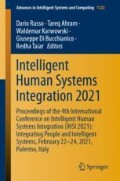Abstract
This paper introduces a novel method of inclusion of human cognition in the form of weight perception in the dynamics and control of a power assist robotic system (PARS) for object manipulation. A 1-DOF test-bed PARS is developed. The dynamics for human-robot co-manipulation of objects is derived that includes weight perception. Then, an admittance control scheme with position feedback and velocity controller is derived from the weight-perception-based dynamics. In the control model, the mass parameter of the inertial force is considered different from that of the gravitational force. The system is simulated in MATLAB/Simulink for 36 different pairs of inertial and gravitational mass parameters. Human subjects lift an object with the system for each pair of parameters separately. The levels of human-robot interaction (HRI) is psychophysically evaluated by subjects separately using a Likert scale. In each trial, the subject evaluates the system for appropriate level of HRI. Then, a training database is generated following the reinforcement learning approach that includes inputs (pairs of mass parameter values) and corresponding outputs (levels of HRI). Then, the labeled database is used to predict a condition where subjects feel the highest level of HRI. Then, the mass parameters for the best HRI pattern are selected as the mass parameters to be used in the control system. In the testing phase, the best mass parameters are used in the control system, and the subjects evaluate the HRI for the system. The results show that the best mass parameters predicted through the reinforcement learning method produce satisfactory HRI, and in the contrary, the mass parameters deviated from the best mass parameters do not produce satisfactory HRI. The results show that inclusion of weight perception in the dynamics and control and optimization of HRI through reinforcement learning are effective.
Access this chapter
Tax calculation will be finalised at checkout
Purchases are for personal use only
References
Rahman, S.M.M., Wang, Y.: Mutual trust-based subtask allocation for human-robot collaboration in flexible lightweight assembly in manufacturing. Mechatronics 54, 94–109 (2018)
Rahman, S.M.M., Liao, Z., Jiang, L., Wang, Y.: A regret-based autonomy allocation scheme for human-robot shared vision systems in collaborative assembly in manufacturing. In: Proceedings of the 12th IEEE International Conference on Automation Science and Engineering (IEEE CASE 2016), pp. 897–902 (2016)
Rahman, S.M.M., Wang, Y.: Dynamic affection-based motion control of a humanoid robot to collaborate with human in flexible assembly in manufacturing. In: Proceedings of ASME Dynamic Systems and Controls Conference, pp. V003T40A005 (2015)
Rahman, S.M.M., Ikeura, R.: Improving interactions between a power assist robot system and its human user in horizontal transfer of objects using a novel adaptive control method. Adv. Hum.-Comput. Interact. 2012, 1–12 (2012). Article no. 745216
Rahman, S.M.M., Ikeura, R.: Cognition-based control and optimization algorithms for optimizing human-robot interactions in power assisted object manipulation. J. Inf. Sci. Eng. 32(5), 1325–1344 (2016)
Rahman, S.M.M., Ikeura, R.: Investigating the factors affecting human’s weight perception in lifting objects with a power assist robot. In: Proceedings of 2012 21st IEEE International Symposium on Robot and Human Interactive Communication, pp. 227–233 (2012)
Rahman, S.M.M., Ikeura, R.: Cognition-based variable admittance control for active compliance in flexible manipulation of heavy objects with a power assist robotic system. Robot. Biomim. 5(7), 1–25 (2018)
Rahman, S.M.M.: Admittance-based bio-inspired cognitive PID control to optimize human-robot interaction in power-assisted object manipulation. In: Proceedings of IEEE/ASME International Conference on Advanced Intelligent Mechatronics, pp. 679–684 (2020)
Neftci, E.O., Averbeck, B.B.: Reinforcement learning in artificial and biological systems. Nat. Mach. Intell. 1, 133–143 (2019)
Botvinick, M., Ritter, S., Wang, J., Kurth-Nelson, Z., Blundell, C., Hassabis, D.: Reinforcement learning, fast and slow. Trends Cogn. Sci. 23(5), 408–422 (2019)
Rahman, S.M.M., Ikeura, R.: Weight-perception-based novel control of a power-assist robot for the cooperative lifting of lightweight objects. Int. J. Adv. Robot. Syst. 9(118), 1–3 (2012)
Rahman, S.M.M., Ikeura, R., Nobe, M., Sawai, H.: A psychophysical model of the power assist system for lifting objects. In: Proceedings of 2009 IEEE International Conference on Systems, Man, and Cybernetics, USA, pp. 4125–4130 (2009)
Rahman, S.M.M., Ikeura, R.: Weight-prediction-based predictive optimal position and force controls of a power assist robotic system for object manipulation. IEEE Trans. Ind. Electron. 63(9), 5964–5975 (2016)
Author information
Authors and Affiliations
Corresponding author
Editor information
Editors and Affiliations
Rights and permissions
Copyright information
© 2021 The Author(s), under exclusive license to Springer Nature Switzerland AG
About this paper
Cite this paper
Rahman, S.M.M. (2021). Psychophysics-Based Cognitive Reinforcement Learning to Optimize Human-Robot Interaction in Power-Assisted Object Manipulation. In: Russo, D., Ahram, T., Karwowski, W., Di Bucchianico, G., Taiar, R. (eds) Intelligent Human Systems Integration 2021. IHSI 2021. Advances in Intelligent Systems and Computing, vol 1322. Springer, Cham. https://doi.org/10.1007/978-3-030-68017-6_9
Download citation
DOI: https://doi.org/10.1007/978-3-030-68017-6_9
Published:
Publisher Name: Springer, Cham
Print ISBN: 978-3-030-68016-9
Online ISBN: 978-3-030-68017-6
eBook Packages: Intelligent Technologies and RoboticsIntelligent Technologies and Robotics (R0)

